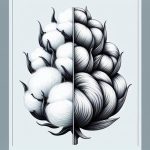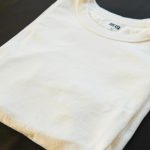When you think about the clothes you wear, have you ever considered the journey of Supima cotton? This premium fabric, known for its softness and durability, starts from sustainable farming practices in the U.S. and goes through a precise manufacturing process before making its way to your wardrobe. Each step, from growing to weaving, plays a crucial role in what sets Supima apart in the fashion industry. But what truly elevates this cotton beyond mere fabric? The answer might surprise you as we explore its impact on both style and sustainability.
Table of Contents
What Is Supima Cotton?
Supima cotton is a premium type of cotton known for its exceptional softness, durability, and vibrant colors. This luxurious cotton is a trademarked brand derived from the U.S. Pima cotton, which is recognized for its extra-long staple fibers. These fibers contribute to the fabric's strength and softness, making it an ideal choice for high-quality clothing and home textiles.
When you choose Supima cotton, you're selecting a product that's not only comfortable but also designed to last. The long fibers help prevent fraying, fading, and unraveling, ensuring your garments maintain their look and feel over time. Supima cotton's ability to absorb dye also means you'll enjoy rich, vivid colors that stay true wash after wash.
Additionally, this cotton is grown primarily in the United States, where strict standards govern its cultivation. This ensures you're getting a product that meets high quality and sustainability standards.
Whether you're dressing in soft Supima cotton t-shirts, luxurious sheets, or cozy towels, you'll appreciate the difference in quality and comfort. So, next time you shop, consider adding Supima cotton to your wardrobe or home for a truly elevated experience.
The Farming Process
When you think about Supima cotton, it's important to understand the farming process behind it.
You'll see how sustainable farming practices play a crucial role in producing this premium fiber.
Additionally, the harvesting techniques used help maintain its high quality and integrity.
Sustainable Farming Practices
Sustainable farming practices focus on nurturing the land and promoting biodiversity, ensuring that cotton production remains environmentally friendly and economically viable. You'll find that these methods prioritize soil health, using crop rotation and cover crops to maintain nutrient levels and prevent erosion. By diversifying what you plant, you reduce pests and diseases, which means less reliance on chemical pesticides.
Water conservation is another vital aspect of sustainable farming. You should adopt techniques like drip irrigation, which delivers water directly to the roots, minimizing waste. This approach not only helps the environment but also cuts costs for farmers.
Moreover, many cotton growers are transitioning to organic practices, eliminating synthetic fertilizers in favor of natural alternatives, which enhances soil quality and supports a healthier ecosystem.
Additionally, integrating livestock into cotton farming can enhance sustainability. By using animals for grazing, you can naturally fertilize the land while controlling weeds. This symbiotic relationship fosters a balanced ecosystem that benefits both crops and livestock.
Ultimately, by embracing these sustainable practices, you contribute to a healthier planet and support the long-term viability of Supima cotton farming.
Harvesting Techniques Explained
After implementing sustainable farming practices, it's time to focus on the harvesting techniques that ensure the quality and efficiency of Supima cotton production. Harvesting is a critical phase that directly affects the fiber's quality, and understanding the methods can give you insight into the care taken during this process.
Here are four primary harvesting techniques used for Supima cotton:
- Mechanical Harvesting: Most farms use specialized machines that efficiently pick cotton while minimizing damage to the plants.
- Hand Harvesting: In some cases, especially for high-quality cotton, workers manually pick the cotton bolls to ensure that only the ripest fibers are collected.
- Strip Picking: This technique involves removing entire branches of cotton bolls, which allows for faster harvesting but may include unripe bolls.
- Desiccation: Some farmers apply desiccants to hasten the drying of cotton plants, making the harvesting process easier and more uniform.
Harvesting Techniques
Many farmers prefer mechanical harvesting for Supima cotton due to its efficiency and ability to minimize damage to the fibers. This method allows you to cover large fields quickly, ensuring that the cotton is picked at the optimal time for maximum quality. Mechanical harvesters use specialized equipment that gently separates the cotton bolls from the plants without harming the delicate fibers.
While mechanical harvesting is favored, some farmers still opt for hand-picking, especially for high-quality Supima cotton. Hand-picking allows for more careful selection and can yield a purer product, as you can avoid contamination with leaves and stems. If you choose this method, be prepared for a labor-intensive process that requires skill and attention to detail.
Regardless of the technique, timing is crucial. You'll want to harvest when the bolls are fully open, indicating that the cotton is ripe. This ensures the best fiber quality and yield. After harvesting, the cotton must be quickly transported to gin facilities for processing, where it will be separated from seeds and prepared for manufacturing.
Each method has its pros and cons, but both aim to preserve the quality that Supima cotton is known for.
Manufacturing and Production
The journey from harvested Supima cotton to finished products involves several key steps that ensure the fibers maintain their exceptional quality.
You'll find that each stage is essential in transforming raw cotton into luxurious textiles.
- Ginning: The cotton is separated from the seeds and debris, ensuring only the purest fibers are processed.
- Spinning: The cleaned fibers are spun into yarn, a critical step where the strength and softness begin to take shape.
- Weaving or Knitting: The yarn is then either woven or knitted into fabric, depending on the desired texture and application.
- Finishing: Finally, the fabric undergoes finishing processes, such as dyeing and treatments, which enhance its appearance and performance.
At each of these stages, meticulous attention to detail is vital.
By using state-of-the-art technology and skilled craftsmanship, manufacturers maintain the integrity of Supima cotton's hallmark qualities: strength, softness, and color retention.
Supima Cotton in Fashion
Supima cotton's luxurious qualities make it a popular choice among fashion designers who seek to create high-end garments that stand out in both comfort and style. When you wear Supima cotton, you immediately notice its softness and durability, which is why designers love incorporating it into their collections. This premium fabric drapes beautifully, allowing for innovative silhouettes that flatter the body.
You'll find Supima cotton in a range of garments, from casual t-shirts to elegant dresses. Its natural breathability ensures you stay comfortable, whether you're at a summer wedding or lounging at home. Plus, the vibrant colors that emerge from Supima cotton's fibers really pop, making your wardrobe choices more striking.
Fashion brands often highlight the use of Supima cotton in their marketing, emphasizing the quality and craftsmanship behind each piece. When you choose Supima, you're not just buying a garment; you're investing in a timeless staple that elevates your style.
Sustainability and Impact
When you consider Supima cotton, you're looking at a product that champions eco-friendly farming practices.
It uses significantly less water than traditional cotton, which means a smaller environmental footprint.
Eco-Friendly Farming Practices
Eco-friendly farming practices play a crucial role in reducing the environmental impact of cotton production while ensuring the sustainability of the industry. By adopting these methods, you're not only contributing to healthier ecosystems but also supporting the long-term viability of cotton farming.
Here are four key eco-friendly practices you can embrace in cotton farming:
- Crop Rotation: Alternating cotton with other crops helps maintain soil health and reduces pest infestations, minimizing the need for chemical pesticides.
- Organic Fertilizers: Utilizing compost and other organic fertilizers enriches the soil without the harmful effects of synthetic chemicals, promoting a more sustainable growing environment.
- Integrated Pest Management (IPM): This approach combines biological, cultural, and chemical tools to manage pests effectively while reducing reliance on harmful pesticides.
- Conservation Tillage: By minimizing soil disturbance, you preserve soil structure, enhance moisture retention, and reduce erosion, all of which are essential for sustainable cotton farming.
Reduced Water Consumption
Adopting eco-friendly practices not only benefits soil health but also leads to reduced water consumption, significantly impacting sustainability in cotton farming. When you choose Supima cotton, you support methods that conserve water while producing high-quality fabric. This cotton variety requires about 50% less water compared to conventional cotton, thanks to its drought-resistant traits and improved farming practices.
Here's a clearer look at water usage in cotton farming:
| Cotton Type | Average Water Usage (gallons per pound) | Water Saving Techniques |
|---|---|---|
| Conventional | 2,700 | Pesticide reduction |
| Supima | 1,350 | Drip irrigation |
| Organic | 1,500 | Cover cropping |
| Transitional | 2,000 | Rainwater harvesting |
| Sustainable | 1,200 | Crop rotation |
Frequently Asked Questions
How Does Supima Cotton Compare to Regular Cotton in Terms of Softness?
Supima cotton's softness is superior to regular cotton. You'll notice it feels smoother and silkier against your skin, thanks to its longer fibers. This difference enhances comfort, durability, and overall quality in your clothing.
Can Supima Cotton Be Blended With Other Fabrics?
Yes, you can blend Supima cotton with other fabrics like polyester or rayon. This combination enhances durability and creates unique textures, while still maintaining the softness and quality that Supima cotton is known for.
Is Supima Cotton More Expensive Than Standard Cotton?
Yes, Supima cotton is generally more expensive than standard cotton. Its superior quality, softness, and durability contribute to the higher price, but you'll find it worth the investment for long-lasting, luxurious fabric.
What Brands Prominently Feature Supima Cotton in Their Collections?
You'll find brands like Ralph Lauren, Calvin Klein, and J.Crew prominently featuring Supima cotton in their collections. They highlight its softness and durability, making it a popular choice for high-quality apparel and home textiles.
How Should Supima Cotton Garments Be Washed and Cared For?
To care for your Supima cotton garments, wash them in cold water with like colors. Avoid bleach and tumble dry on low heat. Iron on medium heat if needed, and always check care labels for specific instructions.
- How Does Ring Spun Cotton Affect Garment Fit and Shape Retention? - August 13, 2024
- What Are the Challenges in Producing Ring Spun Cotton? - August 13, 2024
- Is Ring Spun Cotton Suitable for Plus-Size Clothing? - August 13, 2024







